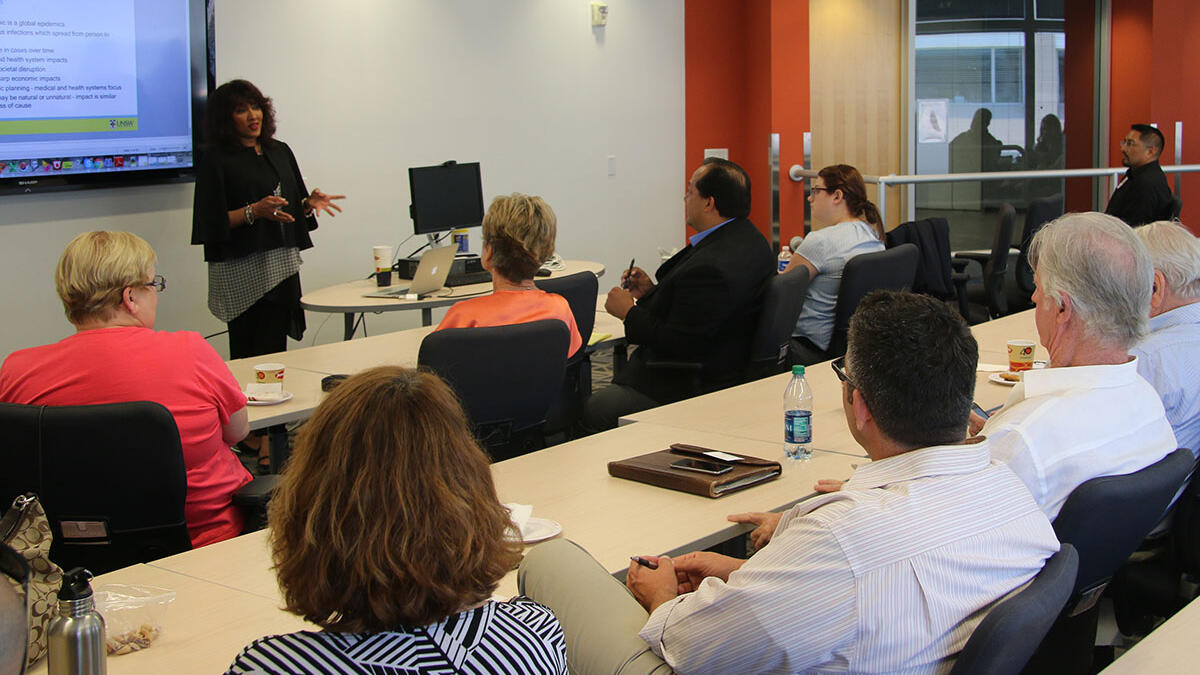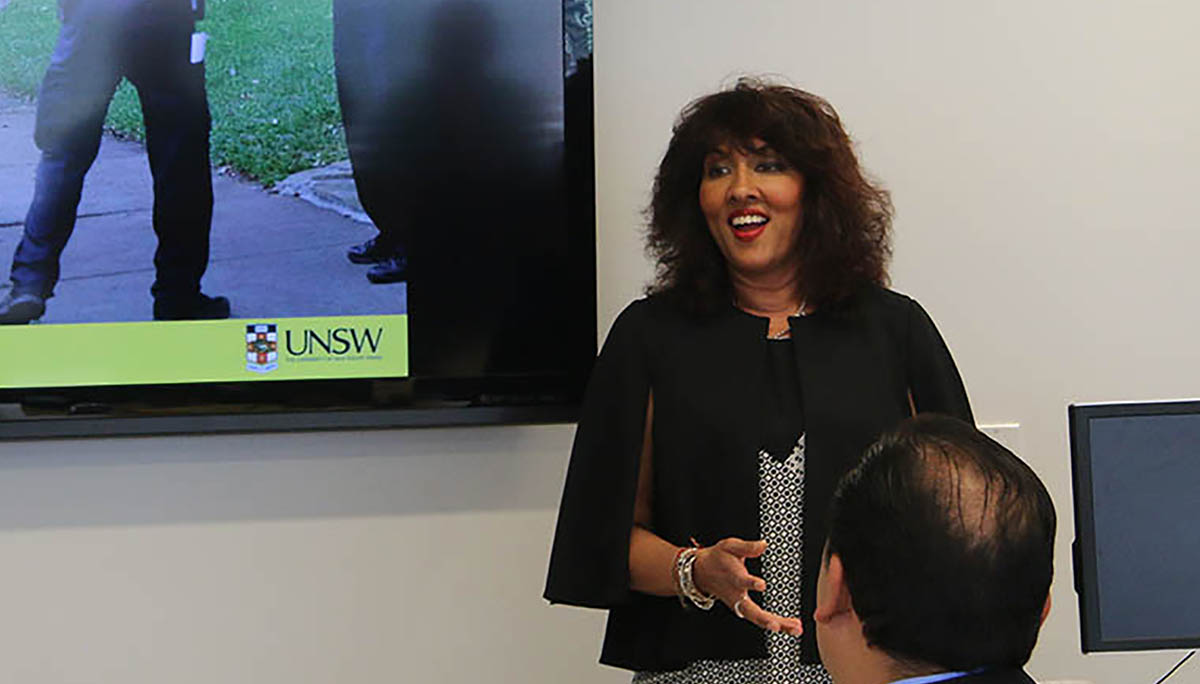ASU expert warns of need to address global biosecurity threats

Raina MacIntyre speaks before an audience of public health professionals, researchers and first responders at ASU SkySong.
Public health physician Raina MacIntyre studies the possibility of global pandemics involving highly contagious infections that spread quickly.
MacIntyre is the head of the School of Public Health and Community Medicine and professor of Infectious Disease Epidemiology at the University of New South Wales in Sydney, Australia. She’s also an adjunct faculty member of the College of Public Service and Community Solutions at Arizona State University.
MacIntyre recently spoke at ASU on pandemics, bioterrorism and biosecurity.
In her presentation at ASU’s SkySong campus in Scottsdale, MacIntyre traced the use of biological agents in warfare to 300 B.C. when Greeks, Romans and Persians used cadavers to contaminate water supplies.
Because of terrorism, the threat posed by the use of harmful micro-organisms is very real today. Many dangerous viruses can be genetically engineered. But MacIntyre made a distinction between typical terrorist acts and bioterrorism. She pointed out that terrorist acts are fairly easy to recognize, whereas the use of biological agents may be difficult for law enforcement and health professionals to ascertain.
Bioterrorism can be targeted at a larger population or a single person. MacIntyre noted the latter could still cause an epidemic because of contagion.
“It’s a highly complex environment, but it is essential to understand the most effective mechanisms to deal with this broad range of challenges falling under the biosecurity rubric,” said Brian Gerber, an associate professor in the College of Public Service and Community Solutions and director of the ASU Emergency Management and Homeland Security graduate program. “She outlined core concepts and principals about what’s at stake and what needs to be done to improve policy and management around various biosecurity threats that exist in the world today.”
A key factor that will help determine whether a biological agent is being used as a weapon is the monitoring of suspicious epidemics by public health officials. MacIntyre suggested that authorities must examine patterns to determine if they are natural or unnatural and alert law enforcement to suspected epidemics. However, she pointed out that asking whether epidemics are natural or unnatural is absent in public health culture, and that most law enforcement agencies lack the tools and expertise to mitigate the risk to their own ranks from bioterrorism. Ideally, investigations should have coordination and collaboration with public health officials.
MacIntyre highlighted the dangers that exist from current infectious diseases and how synthetic genomics allows modified pathogens to be created. She then examined the probability of random genetic mixing of viruses in nature versus genetic engineering and deliberate release creating a pandemic.
"Quantum changes in science — genetic engineering, gene editing, creation of synthetic viruses — have outpaced our regulatory and legal frameworks and leave us vulnerable in biosecurity," MacIntyre said in an interview after her presentation.
MacIntyre recently spoke at ASU on pandemics, bioterrorism and biosecurity in 2016.
MacIntyre questioned whether systems and policies can keep up with rapid developments in science. She cited how conflict of interest is poorly addressed in biosecurity and asked how prepared we are to deal with this contentious issue.
“The average citizen needs to understand the debates about regulation of science versus freedom for researchers, and what the potential impacts on society may be,” said MacIntyre. “They need to be informed and have a voice, because ultimately, potential benefits and harm impact the community."
The Australian researcher also questioned how prepared first responders are to situations involving potentially dangerous pathogens. A raid on premises suspected of containing drugs or weapons are likely to also contain biological agents, she said, and asked how prepared police are for this possibility.
MacIntyre is one of the world’s foremost experts on the effectiveness of specialized respiratory protection used by emergency responders. She walked attendees through research on the use of surgical or medical masks and respirators that filter air. Her studies show how respirators are substantially more effective than surgical masks in the prevention of respiratory infections.
She said those who respond to dangerous situations must assume the worst and have personal protective gear that covers all skin and hair as well as mouth, nose and eyes. MacIntyre went out of her way to explain the importance in properly donning and removing protective gear to prevent self-contamination after the fact. It was something not lost of attendees, which included ASU researchers, public health officials and first responders.
“We’re all learning together about certain weaknesses that we have in our response to these incidents in terms of our personal protection gear and best practices,” said Brian Hickey, a Mesa Fire Department emergency management captain.
MacIntyre’s presentation came as a result of a partnership among ASU, The University of New South Wales in Sydney, Australia and King’s College London. Called the PLuS Alliance, the global learning network will allow students at each university to take online classes from the other schools to enhance their degree. The PLuS Alliance also allows researchers to collaborate on solutions to global challenges.
For students enrolled in ASU’s Master of Arts in Emergency Management and Homeland Security program, the PLuS Alliance network allows them to take online classes from MacIntyre and other public health professors. Conversely, students at the University of New South Wales can enroll in emergency management and homeland security classes offered by ASU, adding a perspective unavailable in their current curriculum.
“What we’ve developed is a way to integrate those two disciplinary perspectives within each of our respective universities,” said Gerber. “So the emergency management and homeland security program has a component for people with a public health background to pursue a graduate degree that incorporates public health considerations into their professional development along with the more traditional emergency management and homeland security issues.”
The College of Public Service and Community Solutions offers a Bachelor of Science in emergency management, an online Master in Emergency Management and Homeland Security, an online Master of Public Safety Leadership and Administration and a Master of Public Administration with a concentration area in emergency management.
More Science and technology

Lucy's lasting legacy: Donald Johanson reflects on the discovery of a lifetime
Fifty years ago, in the dusty hills of Hadar, Ethiopia, a young paleoanthropologist, Donald Johanson, discovered what would…

ASU and Deca Technologies selected to lead $100M SHIELD USA project to strengthen U.S. semiconductor packaging capabilities
The National Institute of Standards and Technology — part of the U.S. Department of Commerce — announced today that it plans to…

From food crops to cancer clinics: Lessons in extermination resistance
Just as crop-devouring insects evolve to resist pesticides, cancer cells can increase their lethality by developing resistance to…
